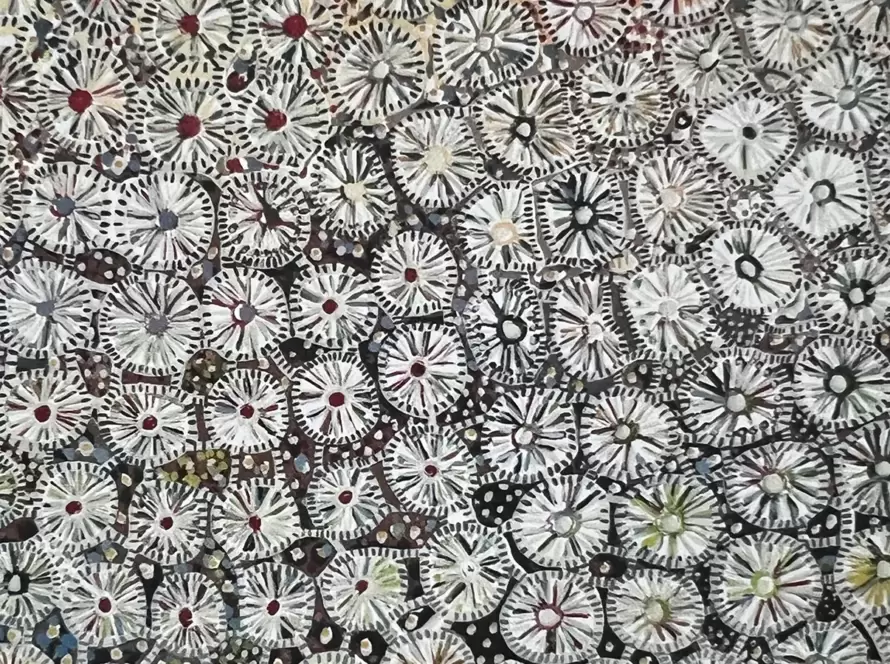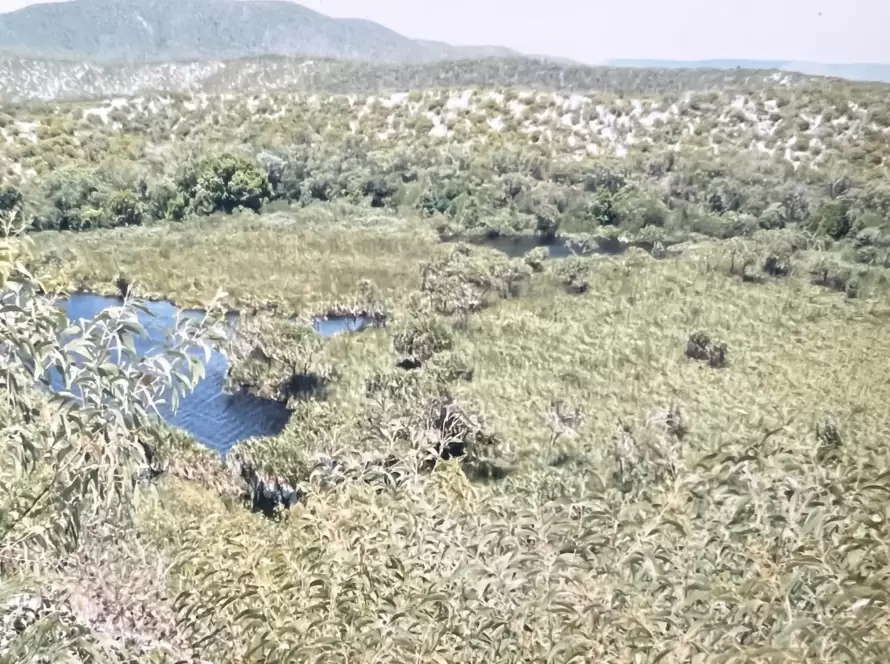![]()
Ngurrgarr (red tailed cockatoo) feather, graphic illustration. © Kristy Day.
Sustainable approaches use only the required natural resources, maintaining a balanced ecosystem for future generations. Indigenous communities across Australia follow this vital value in all aspects of life, coexisting, connecting with and caring for the land. Thanks to Aboriginal sustainability practices, our people, wildlife, earth and sea have flourished together for thousands of years.
Today, traditional principles and processes can help us all to tread more lightly on our planet. The relationship that Aboriginal people share with the land, and the deep ancestral knowledge accompanying it, should be used to inform policy and action for a more sustainable future.
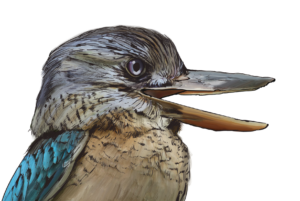
Kooga (blue-winged kookaburra), graphic illustration. The Kooga’s laughter tells us the weather is good and safe for seafaring. © Kristy Day Bowerbird Creative.
Relationship To Country
Systemic thinking is central to Aboriginal sustainability practices. Unlike Western ideologies that consider people, our man-made structures and nature separate entities, our culture views the world – its flora, fauna, earth, water and humankind – as a whole *1. We are all interconnected and interdependent *2.
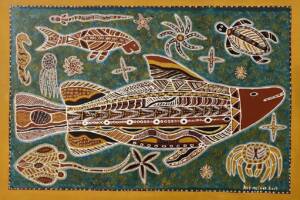
2003. Seascape. © Roy McIvor.
The term ‘Country’ represents this special connection with our land *3. For Aboriginal groups, Country is not a commodity to be owned, exploited or used to stratify the community. Rather, it is everything that we are, from our food and medicine to our song and dance, our ceremony and stories to our ancestors and future.

Caring For Country
Aboriginal communities recognise the devastating impact of depleting natural resources. If our Country is overhunted, overharvested and overexploited, there will be nothing left for future generations. Therefore, caring for Country is a collective responsibility that has always been woven into our ways of life.
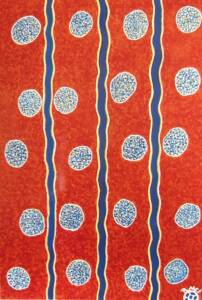
2006. Birri-ngay Gurra Walnga-ngay (Homeland Rivers and Lagoons). © Roy McIvor.
“Special sites of varied and plentiful foods are called ‘thamaan’. It often had special significance as a meeting place for ceremony.
In my country, there are significant rivers; the McIvor and Morgan Rivers, and the creeks and lagoons that it feeds into. Water means life in land, and it supports many other life forms – eels, fish, lily pods, ducks, geese, pigeons and all kinds of other animals and birds. Lagoons were like the refrigerator of the past, a thamaan – a place of plenty.
Old people taught us not to kill or destroy, but to only kill and take enough necessary to feed the group – a good environmental policy” – Binthi Elder Roy McIvor.
The driving force behind Aboriginal sustainability practices for thousands of years, these values can now be incorporated into modern land management strategies *5.
As this connection with the land is integral to Aboriginal Australians’ identity, caring for Country brings benefits beyond the environment, supporting our own health *3, culture, and socio-political and economic well-being.
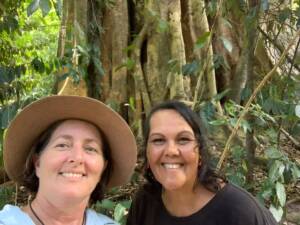
2022. Lyndal Scobell Community Bred Consultant and Ramona McIvor (Binthi Contact Person). Binthi Healthy Country planning fieldwork. © BLHGAC.
By promoting the importance of caring for Country, we can work to develop collaborative partnerships that address our land management concerns, as well as improve community relations with non-Indigenous society *5.
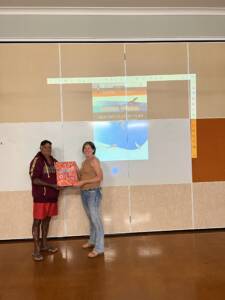
2022. Binthi Healthy Country Planning Workshop. Binthi Director, Ian Woibo presenting Lyndal Scobell, with his artistic granddaughter Ayesha Woibo’s commissioned artwork of a dragonfly (Anisoptera). Community Bred’s logo is the dragonfly. © BLHGAC.
Examples Of Traditional Aboriginal Sustainability Practices
Let’s take a look at some of the Aboriginal sustainability practices that helped to shape and preserve our land for over 70,000 years *6.
Cool burns
Fire management is another Aboriginal sustainability practice that has been used by many rural communities throughout Australia.
Cool burning, otherwise known as fire-stick farming or cultural burning, is a traditional practice whereby slow, low-intensity blazes are intentionally ignited during the early dry season to reduce thick bush that serves as fuel for catastrophic wildfires.
Traditionally, Aboriginal fire practitioners follow the flames on foot, guiding their path until they self-extinguish. This process produces patchy or mosaic-patterned habitats that encourage vegetation regrowth.
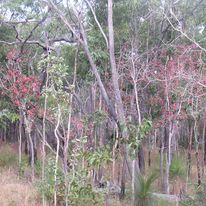
Healthy Binthi Country vegetation regrowth. © BLHGAC.
Cool burns spare young trees, seeds and nutrients within the soil, also helping to restrain competitive exclusion by dominant plant species. Additionally, smaller animals are given an opportunity to thrive, thanks to the preservation of their habitats.
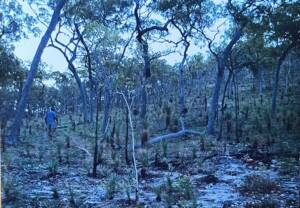
Traditionally burnt country – Binthi bubu (land). © BLHGAC.
Importantly, sustainable fire management demands a rich understanding of the local region, its climate and wildlife. To control a cool burn effectively, Aboriginal people draw on their Traditional Ecological Knowledge of flora, fauna, and natural processes. Such insights shed light on when, where, and how to light the blaze for a constructive and sustainable outcome.
This critical information has been passed down for generations and now helps to inform sustainable land management practices throughout many parts of Australia.
Learn more about Aboriginal fire management.
Fishing traps and dams
Pre colonisation, Aboriginal people managed water resources effectively through sustainable practices that satisfied every need without harming natural resources.
Nets were crafted for particular prey, while dams, channels, river weirs, and fishing traps made from mud, brush, stone or reeds were built on waterways – all small-scale devices with minimal impact on natural processes.
However, as Europeans constructed cities and farms throughout Australia, many Aboriginal communities were forced to relocate and could no longer manage water sources as before.
Instead, settlers acted on their own knowledge of European land and farming methods of farming, often disregarding the consequences for our Country *7. For instance, the introduced horse, sheep and cattle solidified the ground, leading to more water run-off and less soaking into the soil. To keep up with water demands for crops, wetlands were drained and rivers were modified for irrigation.

‘Wandi Walnga’ – Binthi’s brahminy kite spirit sacred lagoon threatened by horses, cattle and weeds. © BLHGAC.
Soon, clear waters teeming with aquatic life became murky and barren. Native species have since been forced to compete for habitats, particularly in hotter, drier areas. Furthermore, groundwater sources are at risk of contamination, mining and over-extraction *7.
These findings point to the importance of considering Aboriginal sustainability practices when developing contemporary water management plans *8.
Careful hunting and harvesting
The increasing demand for food, extensive land clearing and mounting waste is also taking a toll on our Country.
Now more than ever, we must harness Aboriginal knowledge of hunting and harvesting – Aboriginal sustainability practices surrounding food have enabled us to nourish our people, maintain productivity and nurture the land for 2,500 generations already.

Walahn gurra Matharr (Caring and sharing hunters, and lazy hunters). © Roy McIvor.
Our Traditional Ecological Knowledge has evolved over millennia of experiencing and understanding the cycles and patterns of the natural world – including breeding seasons, animal behaviours and the relationships between different species.
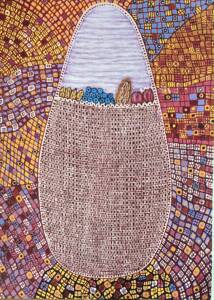
Banyjiin (dilly bag), used for carrying food or straining and leeching poisonous foods, such as black bean seeds, to make a traditional flour. © Roy McIvor.
In response, our considered hunting and harvesting methods ensure minimal disruption to this flow of nature *9.
For example, each season traditionally has a dedicated time to hunt animals, catch fish and harvest fruit, and another time to pick medicines and roots. Food sources are chosen according to availability, with great care given to leave enough behind to replenish resources. Above all, our ancestral hunter and gatherers would focus only on abundant areas, moving on after a certain time so as not to overhunt or overharvest them.
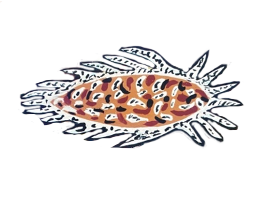
Wugay and Wayaarr (yam) are ready for harvesting when the leaves are dry and fall off. The top of the tubers are replanted so they can reshoot for the next season’s harvest. © Roy McIvor.
However, since colonisation and the subsequent displacement of Aboriginal communities, approximately 100 species of native Australian flora and fauna have become extinct due to land clearing for urbanisation and agriculture, more intense wildfires, and the introduction of predator species such as rabbits, foxes and black rats *10.
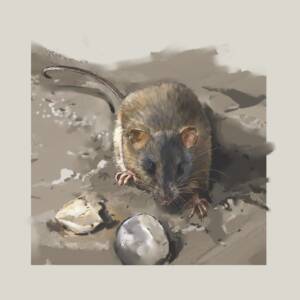
2022. The Abundance Project. Bramble Cay Melomys, Melomys rubicola or Bramble Cays mosaic-tailed rat, was officially declared extinct in 2019. This species was endemic to Bramble Cay, a small island in the Torres Strait, and is regarded as the first mammal to become extinct due to climate change. © Kristy Day.
While some regulations are helping to reduce this loss of biodiversity, there are still around 1,800 threatened species in Australia *11.
There are 1193 species listed on Wetlandinfo in Wildlife of McIvor, Morgan rivers and coastal creeks (which includes Binthi Traditional lands). See the Threatened Species List on Appendix 2, page 67, of our Binthi Warra Healthy Country Plan. The table shows 27 species are listed as critically endangered (1), endangered (5), near threatened (7), and vulnerable (14) under the Nature Conservation Act 1992, with their corresponding Environment Protection and Biodiversity Conservation Act 1999 listing.
Under the Environment Protection and Biodiversity Act 1999, 9 species are listed as vulnerable, critically endangered (1), endangered (1), and extinct (1).
These figures highlight the need for leaders and policymakers across Australia to prioritise our natural environment before it’s too late – a shift that can be informed and facilitated by Aboriginal sustainability practices.
Discover BLHGAC’s Commitment To Sustainability
Aboriginal sustainability practices epitomise successful land stewardship. By connecting with and caring for Country, our traditions have supported Australia’s natural environment to flourish for thousands of generations.
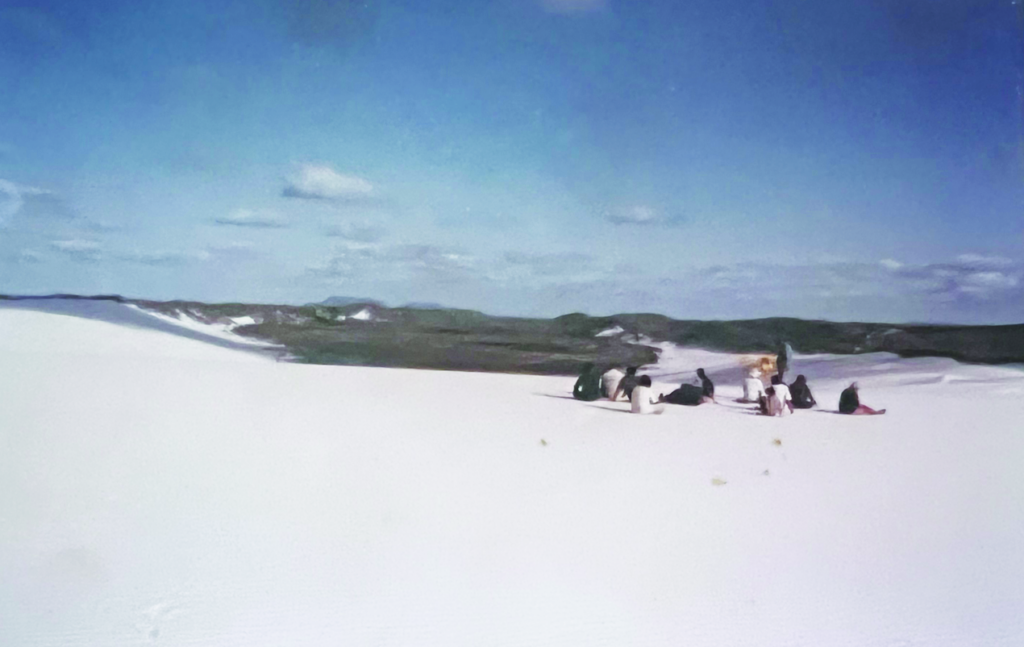
Circa 1993. Binthi Elders on Guti with Cape York Land Council’s Anthropologist Dr Gertrude Stotz, for the mapping and protection of Binthi Country. © BLHGAC.
Today, BLHGAC is recognised for its contributions to conservation and sustainability on the Cape York Peninsula in north Queensland. Our Indigenous Land Management capabilities are crucial not only for the preservation of our culture and customs, but also for our natural resources.
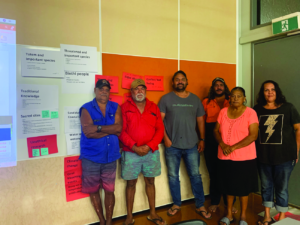
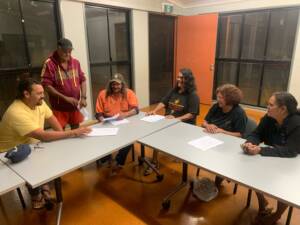
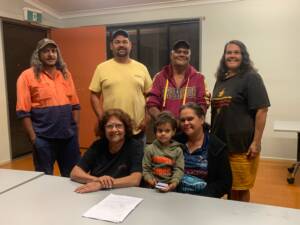
2022. Binthi Warra Healthy Country Planning Workshop. © BLHGAC.
Through considered consultation and preparation, we aim to balance economic development opportunities with the protection of our animals, vegetation and sacred sites. Our Strategic Plan ensures that land management practices are applied appropriately and that all resources are handled with care.
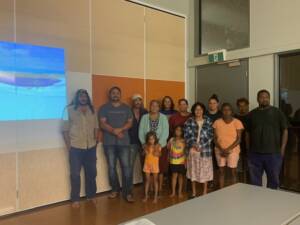
2021. BLHGAC Annual General Meeting. Binthi members met to discuss economic development and conservation. © BLHGAC.
BLHGAC also advocates for Aboriginal methods and Traditional Ecological Knowledge to be incorporated into land management policies, so that we can achieve a more sustainable future.

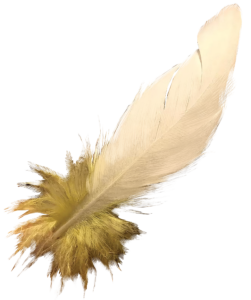
References
- Tilbury, D. and Cooke, K. (2005) A National Review of Environmental Education and its Contribution to Sustainability in Australia: Frameworks for Sustainability – Key Findings. Canberra: Australian Government Department of the Environment and Heritage and Australian Research Institute in Education for Sustainability (ARIES).
- Songoro, R 2019, Prioritise Indigenous knowledges and embed a Western science perspective, IndigenousX, https://Indigenousx.com.au/prioritise-Indigenous-knowledges-and-embed-awestern-science-perspective/
- Christopher P Burgess, E. a. (2009, May 18). Healthy country, healthy people: the relationship between Indigenous health status and “caring for country”. Retrieved from The Medical Journal of Australia: https://www.mja.com.au/system/files/issues/190_10_180509/bur11368_fm.pdf
- Fricker, A 2016, On Country learning: Indigenous studies in education, PowerPoint slides, RMIT University, Melbourne.
- Australian Institute of Aboriginal and Torres Strait Islander Studies. (2011, June). The Benefits Associated with Caring for Country – Literature Review. Retrieved from AIATSIS: https://aiatsis.gov.au/sites/default/files/products/report_research_outputs/benefits-cfc_0.pdf
- Stocking, G.C., Mott, J.J., 1981. Fire in the tropical forests and woodlands of northern Australia, in: Gill, A.M., Groves, R.H., Noble, I.R. (Eds.), Fire and the Australian Biota. Australian Academy of Science, Canberra.
- Beeson, G 2020, A water story: learning from the past, planning for the future, S McInnes (ed), CSIRO Publishing, Clayton South.
- The Fifth Estate. (2019, December). Caring for Country should be a sustainability and green design priority. Retrieved from The Fifth Estate: https://www.thefifthestate.com.au/innovation/design/caring-for-country-should-be-a-sustainability-and-green-design-priority/
- Australian Law Reform Commission (ALRC) 2010, ‘Traditional Hunting, Fishing and Gathering in Australia’, Recognition of Aboriginal Customary Laws (ALRC Report 31), Australian Government, https://www.alrc.gov.au/publication/recognition-of-aboriginal-customary-laws-alrc-report-31/33-traditional-hunting-fishing-and-gathering-practices/traditional-hunting-fishing-and-gathering-in-australia/
- Foley, M 2020, ‘Why is Australia a global leader in wildlife extinctions?’, The Sydney Morning Herald, 20 July, https://www.smh.com.au/politics/federal/why-is-australia-a-global-leader-inwildlife-extinctions-20200717-p55cyd.html
- Cox, L 2018, ‘A national disgrace: Australia’s extinction crisis is unfolding in plain sight’, The Guardian, 13 February.


